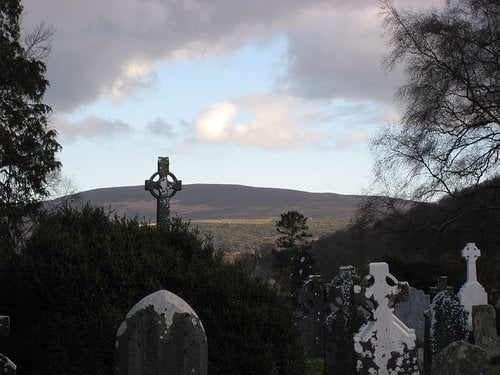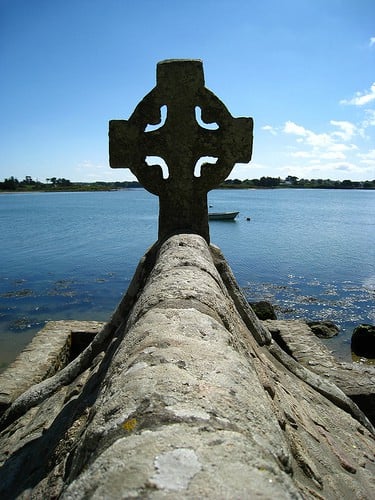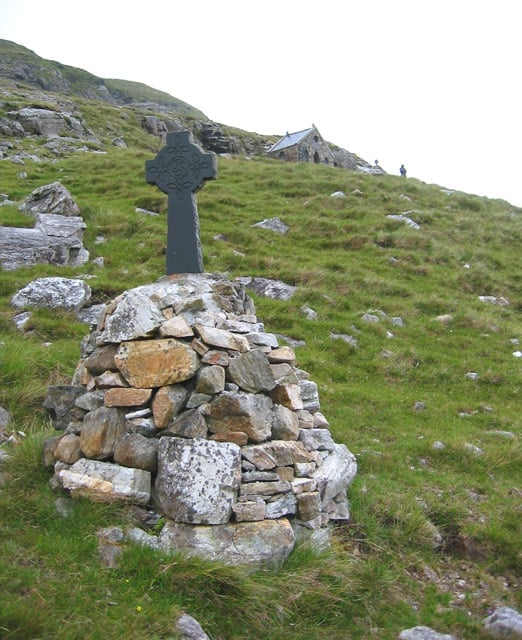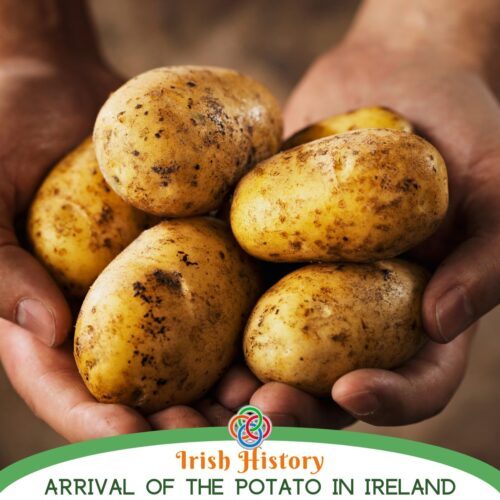The Celtic Cross is a beloved symbol of Ireland. These stone crosses, with a characteristic ring surrounding the central intersection, can be found abundantly in Irish graveyards, but also dotted around the Irish countryside, sometimes in the most unexpected places.

Table of Contents
Celtic Symbolism
Intricately decorated with interlacing motifs, some early examples of Irish Celtic Crosses date back to the 8th century.
As a tribute to Easter, I thought I might share some beautiful images of Celtic Crosses from Ireland and around the world.
Let's delve into some of your questions about Celtic Crosses.
What do Celtic crosses mean?
The Celtic Cross is an important representation of faith in Ireland. They first appeared on the island in the early Middle Ages, and became widespread all over the landscape over the following centuries.
The Celtic Cross features a circular arc surrounding the intersection of the arms and stem of a traditional cross.

The meaning of the Celtic Cross has been debated over the centuries. The four arms of the corss are said to symbolize the four elements, fire, earth, air, and water. The also represent our soul, mind, body and heart.
The center ring symbolizes the Celtic symbol of eternity, with no beginning and no end. It also reprsents the halo of Christ and God;s endless love. The ring also gives the cross strength reinforcing the four arms of the cross.
Definition of a Celtic High Cross
To be considered a Celtic High Cross the ornamental monument must be at least 800 years old.
Any younger and the cross is simply a Celtic Cross. The picture above was taken in Glendalough, the ancient monastery of St. Kevin in Co. Wicklow which dates back to the early years of the 7th century.

The Land of Saints and Scholars
Ireland was once known as the "island of saints and scholars." Many monastaries were dotted all over the landscape of Ireland. Monks and nuns devoted their lives to prayer, meditation and study.
Scriptoriums were created to record the ancient history of Ireland, and to record the verses of the bible.
Irish Celtic Cross designs found in these monasteries often featured biblical scenes.
This cross photographed above is located in Clonmacnoise, County Offaly, on the banks of the river Shannon. This great center of learning was founded between 545 and 548.
This High Cross above is known as the Celtic Cross of the Scriptures. Ornately carved and decorated this Irish high cross features carvings of scenes from the bible and of Christ's crucifixion.
The original High Crosses at Clonmacnoise were built around the 10th century. However, they have been moved into the visitor's center for preservation purposes. Replicas of the originals now stand in their place.

Did Saint Patrick Create the Celtic Cross?
As with all things Irish, legends abound regarding the true origins of this iconic symbol. One such ancient tale tells how St. Patrick created the cross to assist him in converting the pagan Irish to Christianity.
He combined a traditional Latin cross with the circular, pagan, moon Goddess symbol to help underscore the power of Christ over the moon and the sun.
St. Patrick may have created a Christian cross by combining ancient celtic symbolism with a traditional Christian cross. Like other early Christian missionaries to Ireland in the 5th century, Patrick would have taken great care not to offend the native Celtic people, in his quest to convert them to the Christian faith.
For the Celts, the sun god Lugh was very important. The circle of the cross represents the sun, and is linked to the pagan roots of the Celtic Cross. In addition, it's a symbol of eternity and God's infinite love. Christian missionaries explained that it represents Christ's halo and the circle of life.
The basic shape of these crosses included a tall shaft, which mirrored trees, important ancient Celtic symbols.

This photo of an Irish graveyard clearly underscores how much Irish people embrace this symbol of their faith.
Celtic cross headstones are the predominant design found in Irish cemeteries.
This Cross of Christ is an ancient symbol that many Irish people choose as a representation of the Irish people.
During the Celtic revival of the 18th century, Celtic Crosses became popular as headstones, and began to appear more frequently in Irish graveyards. This tradition continues to this very day.
Where are Celtic Crosses Found?
Celtic crosses are found throughout the British Isles, especially in Cornwall, Scotland and Wales, and all the Celtic regions of the world.
This includes Brittany in France, and the Isle of Man which lies in the Irish sea between England and Ireland.

The example above can be found in Brittany in France, which is considered one of the six Celtic nations (Brittany, Cornwall, Ireland, Isle of Man, Scotland and Wales).
Our Celtic ancestors shared their love of this ancient Celtic and Christian symbol wherever they called home.

Wherever the Irish have roamed, settled and passed on to the next life, they have brought their Celtic crosses with them. The image above is from a cemetery in Australia.
Many Irish were sent to Australia during the 19th century as punishment for crimes, both large and small.

Here is an example of a Celtic cross in New York State.
There are millions of people in America of Irish ancestry, and Celtic crosses can be found in many cemeteries in the United States.
This love of the Celtic Cross continues in Irish America to this very day.

Celtic crosses can be found in rugged, out-of-the way places such as this Station of the Cross found on the side of a hill in the Mamturk mountains in Co. Galway.
Celtic Crosses Inspire Artists and Jewelers
The Celtic cross gives inspiration to jewelery designers today, and is used extensively by tattoo artists. You will also see Celtic Cross motifs on t-shirts, mugs and other Irish gift designs.
How this symbol is evolving and being embraced as a modern day emblem highlights its great power and meaning. New interpretations can never erase its history and iconic connection to our forefathers.
Many readers ask for recommendations on where to buy Celtic Cross jewelry. I recommend the Irish company, Celtic Cross Online. They carry a lovely selection of crosses, at many different price points.
Wearing Celtic Cross pendants is a wonderful way for Irish people to celebrate our Irish heritage and Irish culture, and to show off our Irish pride.
And so, to all who choose to proudly wear a Celtic Cross, do not merely think of it as a modern symbol of today's culture. Always remember it symbolizes Celtic folklore, our Christian heritage, and deeply roots us to our ancient past.

Slán agus beannacht,
(Goodbye and blessings)
Mairéad -Irish American Mom
Pronunciation - slawn ah-gus ban-ock-th
Mairéad - rhymes with parade
P.S. Thank you to all the wonderful and generous photographers who so graciously share their amazing works under a creative commons license.














Kay G.
"Deeply roots us to our ancient past"...what a lovely, lovely post.
Thank you for this.
Happy and Blessed Easter to you.
Irish American Mom
Easter blessings to you and your family too, Kay. I hope you have a lovely weekend.
Brian@irelandfavorites
Happy Easter, When I first opened my shop a fella asked me what the meaning of circle of the celtic cross. I told him I wasn't sure but would find out for him, when he realized I wasn't going to fake my way through an answer he proceeded to informed me of the different meanings , which you so accurately stated. Thanks again, and from reading your site I know you will have a lovely spread for your Easter feast.
Irish American Mom
Brian - I hope you and your family have a lovely Easter too. Best wishes!
Chris
The circle of life often describes a community coming together. The symbol existed in pre-christian times too in the form of stone circles and markings from neolithic times representing the Sun. This was later adapted as a christian smbol along with many other old pagan customs and beliefs.
Irish American Mom
Chris - Thank you for adding this information about the circle of life and how the circle is an important pre-Christian symbol of pagan Ireland, adapted and incorporated into christian emblems of a later era. Thanks so much for vising and commenting.
Charlie Taylor
The 7th Celtic Nation is Galiciia in Spain .
Irish American Mom
Thanks for letting us know about Galiciia in Spain. I was unaware of this one. I wonder if there are any Celtic Crosses there.
Ciaran dinsmore
Hav u seen the Celtic cross in the village of Donaghmore Co Tyrone.it was restored a few years back.
Irish American Mom
I haven't seen it yet Ciaran, but definitely hope to see it someday when I'm heading towards Donegal where my husband was born.
All the best,
Mairéad
Constance Lyon
till Ireland separated itself during a War-from England and Britain
Irish American Mom
Hi Constance - In 2016 as we celebrated the 100th anniversary of the 1916 rising, there was a renewed interest in all things Irish, including beautiful symbols of my homeland such as the Celtic Cross.
Thanks for stopping by,
Mairéad
Constance Lyon
they have the Beautiful red hair and blue eyes
Irish American Mom
🙂 🙂 🙂
Ciaran dinsmore
Yip I have red hair and blue eyes
Ciaran dinsmore
And We celebrated the 100th anniversary in Dublin because bein from dungannon.tom Clarke is our hero.
Irish American Mom
Thanks so much for stopping by and adding to our discussion.
All the best,
Mairéad
Irish American Mom
Ever so Irish. 🙂 🙂 🙂